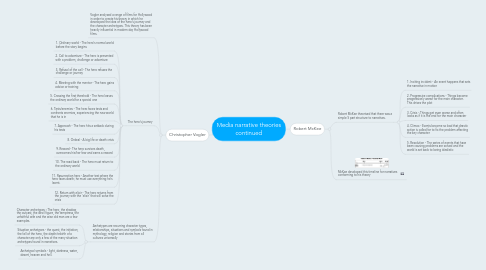
1. Robert McKee
1.1. Robert McKee theorised that there was a simple 5 part structure to narratives.
1.1.1. 1. Inciting incident - An event happens that sets the narrative in motion
1.1.2. 2. Progressive complications - Things become progressively worse for the main character. This drives the plot
1.1.3. 3. Crisis - Things get even worse and often looks as if it is the end for the main character
1.1.4. 4. Climax - Events become so bad that drastic action is called for to fix the problem affecting the key character
1.1.5. 5. Resolution - The series of events that have been causing problems are solved and the world is set back to being idealistic
1.2. McKee developed this timeline for narratives conforming to his theory
2. Christopher Vogler
2.1. Vogler analysed a range of films for Hollywood in order to create his theory in which he developed the idea of the hero's journey and the character archetypes. This theory has been heavily influential in modern day Hollywood films.
2.2. The hero's journey
2.2.1. 1. Ordinary world - The hero's normal world before the story begins
2.2.2. 2. Call to adventure - The hero is presented with a problem, challenge or adventure
2.2.3. 3. Refusal of the call - The hero refuses the challenge or journey
2.2.4. 4. Meeting with the mentor - The hero gains advice or training
2.2.5. 5. Crossing the first threshold - The hero leaves the ordinary world for a special one
2.2.6. 6. Tests/enemies - The hero faces tests and confronts enemies, experiencing the new world that he is in
2.2.7. 7. Approach - The hero hits a setback during his tests
2.2.8. 8. Ordeal - A big life or death crisis
2.2.9. 9. Reward - The hero survives death, overcomes his/her fear and earns a reward
2.2.10. 10. The road back - The hero must return to the ordinary world
2.2.11. 11. Resurrection hero - Another test where the hero faces death; he must use everything he's learnt.
2.2.12. 12. Return with elixir - The hero returns from the journey with the 'elixir' that will solve the crisis
2.3. Archetypes are recurring character types, relationships, situations and symbols found in mythology, religion and stories from all cultures universally
2.3.1. Character archetypes - The hero, the shadow, the outcast, the devil figure, the temptress, the unfaithful wife and the wise old man are a few examples.
2.3.2. Situation archetypes - the quest, the initiation, the fall of the hero, the death/rebirth of a character are only a few of the many situation archetypes found in narratives.
2.3.3. Archetypal symbols - light, darkness, water, desert, heaven and hell.
